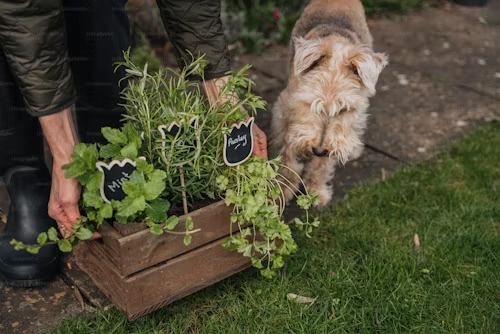Can Dogs Get Poison Ivy? Understanding Risks and Treatments

Poison ivy is a well-known irritant for humans, but what about our furry friends? Many pet owners wonder whether their dogs can also suffer from the effects of this notorious plant. In this comprehensive guide, we will explore whether dogs can get poison ivy, the symptoms to look out for, how to treat it, and ways to prevent exposure.
What Is Poison Ivy?
Poison ivy (Toxicodendron radicans) is a plant commonly found in wooded and grassy areas across North America. It is notorious for causing skin irritation in humans due to an oil called urushiol, which is found in all parts of the plant—leaves, stems, and roots. Urushiol can cause allergic reactions when it comes into contact with the skin.
Key Characteristics:
- Leaves: Poison ivy typically has clusters of three leaflets. The edges of the leaves can be smooth or have slight teeth.
- Growth: It can grow as a vine or a small shrub.
- Color: The leaves are green but may turn red or orange in the fall.
- Berries: Poison ivy produces small, white or yellow berries.
Can Dogs Get Poison Ivy?
While dogs cannot get poison ivy in the same way humans do, they are not entirely immune to its effects. Here’s how poison ivy can affect dogs:
1. Contact with Urushiol
Dogs can come into contact with poison ivy if they brush against the plant or walk through areas where it’s growing. The urushiol oil can transfer to their fur, skin, and even to surfaces inside your home. While dogs generally don’t have the same allergic reaction as humans, they can still experience irritation and develop a rash.
2. Transfer of Urushiol
The urushiol oil from poison ivy can cling to a dog’s fur and be transferred to humans or other animals. This means that while the dog itself may not be severely affected, the oil on its fur can cause reactions in people who come into contact with the dog.
Symptoms of Poison Ivy Exposure in Dogs
Identifying poison ivy exposure in dogs can be challenging since they cannot tell you where they are itching or how they feel. Look for the following symptoms:
1. Skin Irritation
- Redness: The affected area may become red and inflamed.
- Rash: Dogs might develop a rash or hives, often on the belly, paws, or around the face.
- Itching: Excessive scratching or biting at the skin can indicate irritation.
2. Digestive Issues
- Vomiting: If a dog chews or ingests parts of the poison ivy plant, it might vomit.
- Diarrhea: Ingestion of urushiol can lead to gastrointestinal upset.
3. Behavioral Changes
- Discomfort: If your dog is unusually restless or appears to be in pain, it might be due to irritation.
- Lethargy: In severe cases, your dog might become lethargic or less active.
Treatment for Poison Ivy Exposure in Dogs
If you suspect your dog has been exposed to poison ivy, here’s what you can do:
1. Bathe Your Dog
- Immediate Washing: Rinse your dog with lukewarm water as soon as possible to remove any urushiol from the fur. Use a gentle dog shampoo to help break down the oil.
- Repeat as Necessary: In some cases, you may need to bathe your dog multiple times to ensure all traces of urushiol are removed.
2. Clean the Environment
- Wash Bedding and Toys: Clean any bedding, toys, or surfaces your dog has come into contact with to remove any residual urushiol.
- Vacuum and Clean: Thoroughly vacuum and clean areas where your dog may have transferred the oil.
3. Treat the Symptoms
- Anti-Itch Remedies: Over-the-counter anti-itch creams designed for dogs may help alleviate discomfort. Consult your vet before using any medication.
- Veterinary Consultation: If symptoms are severe or persistent, consult your veterinarian for appropriate treatment. They may prescribe medications or topical treatments to manage inflammation and itching.
4. Monitor for Secondary Infections
- Check for Infection: Excessive scratching can lead to skin infections. Keep an eye on your dog’s skin and seek veterinary care if you notice any signs of infection, such as pus or increased redness.
Prevention Tips
Preventing poison ivy exposure is the best way to protect your dog. Here are some tips to help keep your furry friend safe:
1. Identify and Avoid Poison Ivy
- Know the Plant: Familiarize yourself with the appearance of poison ivy to avoid areas where it grows.
- Leash Walks: Keep your dog on a leash during walks to prevent them from wandering into areas with poison ivy.
2. Groom Regularly
- Routine Baths: Regular grooming can help remove any oils or allergens that may cling to your dog’s fur.
- Check Fur and Skin: After walks or outdoor activities, inspect your dog’s fur for any signs of contact with potential irritants.
3. Use Protective Gear
- Doggie Booties: In areas where poison ivy is prevalent, consider using protective booties for your dog’s paws.
- Protective Coatings: Some products claim to create a barrier on the skin to prevent allergens from sticking. Consult with your vet about the safety and efficacy of such products.
4. Educate Yourself and Others
- Inform Family and Friends: Ensure that everyone in your household is aware of the risks associated with poison ivy and takes steps to prevent exposure.
- Avoid Outdoor Areas with Poison Ivy: If you know a certain area is infested with poison ivy, avoid bringing your dog there.
When to See the Vet
If you’re unsure whether your dog’s symptoms are related to poison ivy or if they appear to be worsening, seek veterinary care. It’s especially important to consult with a vet if your dog:
- Shows severe symptoms or if there’s widespread rash or discomfort.
- Has ingested any part of the poison ivy plant.
- Exhibits signs of secondary infections or unusual behavior.
Conclusion
While dogs are not as susceptible to poison ivy as humans, they can still experience irritation from contact with the plant. Understanding the symptoms, treatment options, and preventive measures can help you keep your dog safe from the effects of poison ivy. By staying vigilant and taking proactive steps, you can minimize the risk of exposure and ensure your furry friend stays healthy and comfortable. If in doubt, always consult your veterinarian for the best course of action.




